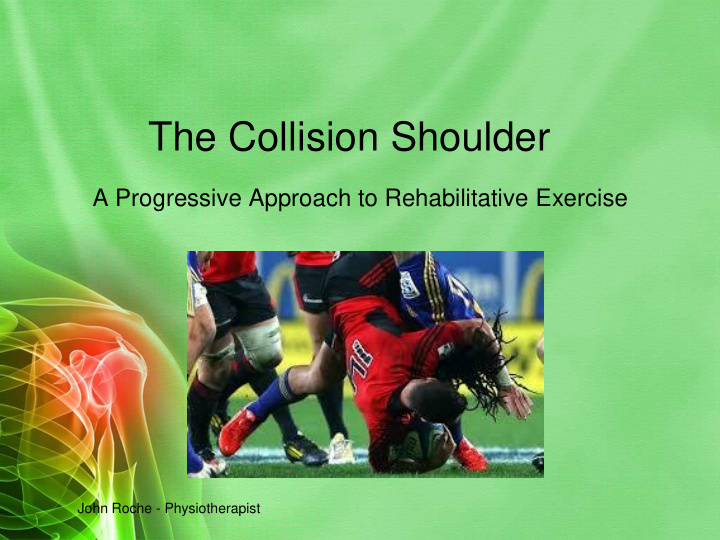



The Collision Shoulder A Progressive Approach to Rehabilitative Exercise John Roche - Physiotherapist
A Rugby Perspective The 2012 Canterbury team was surveyed for a Research project conducted by Khalid Mohammed: Mohammed K et al Orthopaedics and Trauma [2015] http//doi.org/10.1016/j.mporth.2.014.12.007 • 56% had already had shoulder surgery [60% of forwards surveyed; 40% of backs] • 2/3 of group had missed game-time because of shoulder injury • All surveyed players had returned to rugby following injury/surgery
Surgical Cohort
Rehab Focus Areas • Postural Awareness/ Control [Review neutral position of shoulder] • Mobility [while avoiding over-stressing damaged tissue] • Scapula Control/ Stability [+core] • Rotator Cuff Strength/ Co-ordination • Functional Strength • Return to Desired Activity Level
Pendular Exercises • Can be useful for reducing low level pain and maintaining joint mobility in early stages post injury • 60 secs every 2-3 hours • Consider cryotherapy for pain
Postural Control • Neutral Position of Glenohumeral Joint = midway position between protraction/retraction + elevation/depression • Ensure patient doesn’t develop a “sick scapular”
PosturalControl • Focus/ awareness on good posture through lumbar/ thoracic spine and maintenance of good scapula position [NB: Difficult to maintain good scapula position with stiff thoracic spine] • Think of how to provide feed-back: mirror; family members; coaches etc • Regular cues throughout day
Mobility Don’t force ROM - should not be painful • Active Assisted flexion • Use stick/ pulley/ wall slide • Rotations in supine with focus on scapula position • Abduction in plane of the scapula • Pool: water-supported/ resisted exercise • Physio = joint mobilisation/ manual therapy + exercise prescription
Scapula Stability Exercises Prone scapula retraction • Good scapula position • Use lower traps/ rhomboids, not latissimus dorsi
Scapula Stability Exercises Bungee Row
Scapula Stability Exercise 4 point-kneeling with arm lift
Scapula Stability Exercise • Side-on to wall • Set scapula and rotate/ perform single-arm press-up etc
Rotator Cuff Strengthening • Theraband/ Tubing exercises: [focus on good scapula “setting” and performing the exercise with control] • Ext rot/ Int rot/ abd • Start slow and controlled • Progress load • Progress speed/ eccentric load • Consider sets/reps/resistance progression
Dumb-bell Exercise • Always focus on good scapula control/position • External rotation in side-lying • Lateral raise in plane of scapular • IR/ER with scapular control • Other examples
Upper Body Strengthening • Muscular Endurance Vs Strength Vs Power - Consider resistance/ sets/ reps • Consider athletes requirements for function • “Pushing Exercise” [floor press/ bench press/ shoulder press] • “Pulling Exercise” [seated row/ bent -over row/ lat pull-down]
Regaining Function • Return to Play = 2 weeks full training • Progress to this level via controlled coaching of technique [collision/ tackle/ landing/ catching etc] • Same philosophy with return to work
A Useful Resource A Useful Resource
Recommend
More recommend